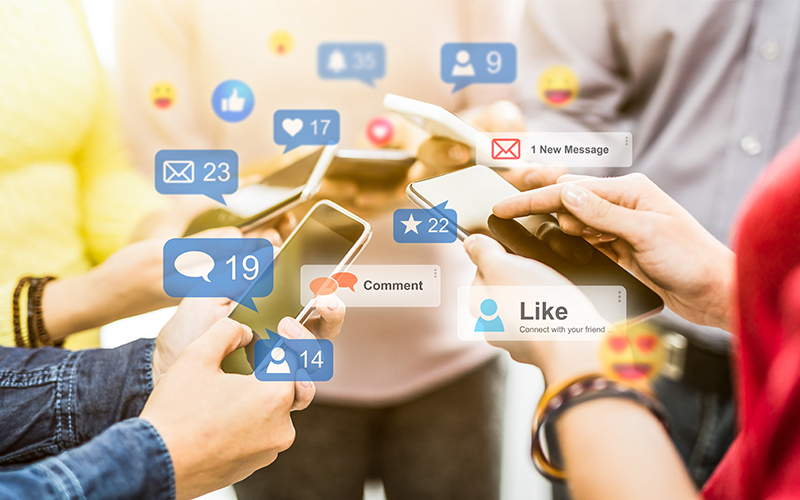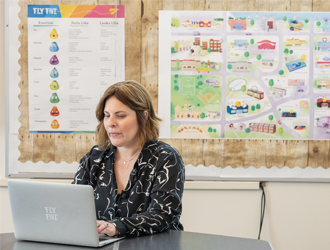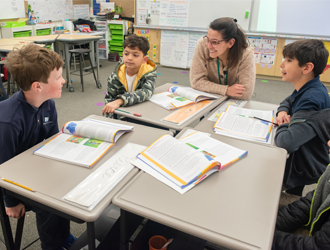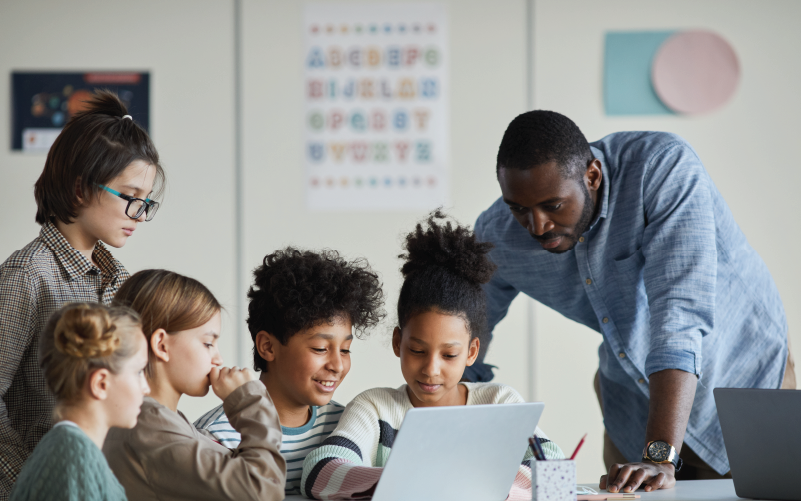Technology Break

How do you feel after spending a long time looking at a screen? Even if you don’t know how much time you actually spend looking at your screen, there has likely been at least a day or two since the start of the pandemic that you’ve spent a bit more time online than you meant to. Perhaps you felt the fatigue behind your eyes or the kink in your neck from looking down at your phone or up at your laptop. Does it seem like your screen time has gone up over the last twelve months?
If the answer is yes, don’t be surprised. Screen time has increased for students across grade levels, sometimes as much as nearly thirty percent (Statista, 2020), and the stay-at-home guidelines have also caused increased screen time for adults across different populations, as well (Sultana et al., 2020). While increased screen time makes sense for maintaining our work and relationships during COVID-19, it’s important that we are informed consumers of technology. This means understanding how our apps and devices are designed to keep us scrolling, having a firm grasp on the mental and physical implications of screen time, and making mindful choices about how we use our technology.

As you likely know, our social media apps are powered by algorithms. They are designed “to provoke rather than be a beacon of truth” (Turk, 2020), as clicks translate into revenue; companies have a vested interest in designing apps that keep us as engaged as possible. Social media algorithms reproduce content based on our behavior and interactions, which means that even if we follow the same accounts as a friend, our feeds will be personalized based on our likes, saves, etc. Engineers created the actions we’ve come to know as normal, such as the “like” button and the ability to infinitely scroll, which can keep us scrolling through content, curated just for us, for much longer than anticipated.
In addition to designing a feed based on our behaviors, the apps offer us rewards (likes, shares, messages). These rewards trigger a dopamine rush in our brain (Addiction Center, 2020), and the apps are designed to dole out rewards on a seemingly random schedule. When we perceive these rewards to be random, we are apt to check for them habitually, even at the slightest twinge of boredom (Haynes, 2018). We also typically get a higher dopamine rush when we speak about ourselves, which we tend to do at much higher frequencies online than we do offline (Addiction Center, 2020). Furthermore, the more we use social media, the more likely we are to receive rewards. For instance, the more you begin liking pages and friending people on Facebook, the more notifications you’ll receive. This increases the likelihood of the random reward, which can reinforce the habitual behavior of checking for that reward (Haynes, 2018).
Understanding how social media is designed to keep us coming back for more can empower us to take control of our technology use. We can inform our students and families of the ways that screen time and social media impact us and work together to maintain healthy boundaries between us and our phones.

When thinking about how and when you and your family spend time on your screens, it can be useful to think about digital wellness. Digital wellness is defined as “a way of life, while using technology, that promotes optimal health and well-being in which body, mind, and spirit are integrated by the individual to live more fully within the human, natural, and digital communities” (Royal et al., 2017). This framing reminds us that our devices are there to augment our lives and relationships, to forge connection and community, and to deepen our work and learning. When we consider our technology use in terms of wellness, we can make more intentional choices to use our technology productively.
Assessing how you use your devices can be categorized as a means of assessing your overall health— putting your phone away before bed isn’t restrictive, it’s beneficial for your sleep. When we think of all the positives that come with using our phones in moderation and with intention, it may be easier to break the habit of scrolling during commercials.
The same can be true when speaking with your kids about their screen time. Highlight the benefits of reducing time spent online in terms relevant to their lives.
Below are some strategies for using your devices mindfully:
- Turn off tech before bed and in the morning. The blue light of our devices has been shown to disrupt sleep patterns by suppressing our melatonin secretion (Ruder, 2019), which is important for a good night’s sleep. As a family, put all devices away before bedtime, ideally a half an hour or more before it’s time to sleep (Hogenboom, 2018). If children (or you!) are having trouble disengaging from the phone, replace the habit with another bedtime ritual, like reading, working on a puzzle, coloring, or journaling. Similarly, don’t start the day with a scroll through social media. Rather than beginning the day by seeing everything we’ve missed since the night before or facing our to-do list, we can leave our phones on silent while we get present in our own lives (Tejada, 2019).
- Take a family tech break.Carve out time when all members of the family put their devices away. This can be during meals, for the first hour of the day, or on a family outing. Remind young people that enjoying experiences for themselves is important, and that their experiences are no less valid if they aren’t sharing it to their social media.
- Ask yourself and your family their intentions when posting. Is the post to share something joyful? Is it for validation? What is your mood when posting, and how do you feel if you don’t get as many likes as you’d hoped? These are all important questions to discuss with your family and reflect on yourself, as they foster more mindful social media use. Once you’ve identified the need, either in yourself or your children, consider if there may be a more constructive way to meet that need (University of Washington, 2020).
- Remember that not all screen time/social media use is the same. Consider how you and your family use your devices. Are you active or passive? Passive social media use is more closely associated with increased symptoms of depression (Escobar-Viera et al., 2019). Instead, use your social media with your family to model community-building and positive engagement online. Have a purpose when you go online, and find ways to use technology to add value to your life. This can include bonding with your family over a binge-worthy TV show or podcast, listening to audiobooks, or using games and apps for educational purposes.
- Limit time spent on social media. Studies suggest that people who use social media for more than two hours per day have lower self-esteem than those who do not (University of Washington, 2020). Set timers to let you know when you’ve reached your allotted time for the day. Like any habit, we can set ourselves up for success by removing temptation— turn off notifications so you aren’t tempted to open your apps at any given moment. Notice when you find yourself mindlessly scrolling and replace that habit with something else. Do you usually scroll during commercial breaks? Try coloring. Do you open your apps when you’re waiting in line for a coffee? Use that time to have a mindful moment and notice five new things in the coffee shop.
Our devices in general, and social media more specifically, have likely taken a more prominent role in our lives since the start of the pandemic. As our screen time inevitably increases while we work to stay connected and engaged with our students, colleagues, and loved ones, our anxiety surrounding the implications of that screen time for ourselves and our students may increase as well. What’s important to remember is that we are in control of how we use technology. When we take steps to limit mindless scrolling and use our devices intentionally, we can model positive behavior for our families and students and use technology to deepen our learning and improve our lives during this difficult time.
Works Cited
Addiction Center. (2020, November 20). Social media addiction. https://www.addictioncenter.com/drugs/social-media-addiction/.
Escobar-Viera, C., Shensa, A., Bowman, N.D., Sidani, J.E., Knight, J., James, A.E., & Primrack, B.E. (2018, July 1). Passive and active social media use and depressive symptoms among United States adults. Cyberpsychology, Behavior, and Social Networking, 21(7): 437-443. https://doi.org/10.1089/cyber.2017.0668.
Haynes, T. (2018, May 1). Dopamine, smartphones, & you: A battle for your time. Harvard University Graduate School of Arts and Sciences: Science in the News Blog. http://sitn.hms.harvard.edu/flash/2018/dopamine-smartphones-battle-time/.
Hogenboom, M. (2018, January 11). The vital time you shouldn’t be on social media. BBC Future. https://www.bbc.com/future/article/20180110-the-vital-time-you-really-shouldnt-be-on-social-media.
Ruder, DB. (2019, June 19). Screen time and the brain. Harvard Medical School. https://hms.harvard.edu/news/screen-time-brain.
Royal, C., Wasik, S., Horne, R., Dames, L. S., & Newsome, G. (2017). Digital Wellness: Integrating Wellness in Everyday Life with Digital Content and Learning Technologies. In Keengwe, J., & Bull, P. H. (Ed.), Handbook of Research on Transformative Digital Content and Learning Technologies (pp. 103-117). IGI Global. http://doi:10.4018/978-1-5225-2000-9.ch006.
Statista. (2020). Children and teens from the United States who spent more than four hours daily using electronics devices before and during the coronavirus pandemic according to parents as of June 2020, by age group. https://www.statista.com/statistics/1189204/us-teens-children-screen-time-daily-coronavirus-before-during/.
Sultana, A., Tasnim, S., Bhattacharya, S., Hossain, M.M., & Purohit, N. (2020, September 1). Digital screen time during COVID-19: A public health concern. SocArXiv. DOI: 10.31235/osf.io/e8sg7.
Tejada, C. (2019, December 12). Why your phone shouldn’t be a part of your morning routine. Huffington Post Canada. https://www.huffingtonpost.ca/entry/dont-check-phone-in-morning_ca_5df24c1ae4b01e0f295b6d0a.
Turk, M. (2020, November 1). Tomorrow’s mind: The end of self-control. The Stanford Daily. https://www.stanforddaily.com/2020/11/01/the-end-of-self-control/.
University of Washington. (2020). Digital wellness 101: Taking control of your life online. https://www.washington.edu/studentlife/digital-wellness-101-sr/.








